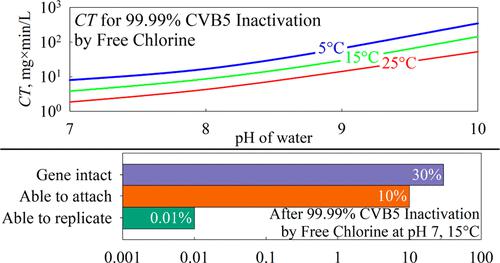当前位置:
X-MOL 学术
›
Environ. Sci. Technol.
›
论文详情
Our official English website, www.x-mol.net, welcomes your
feedback! (Note: you will need to create a separate account there.)
Inactivation Kinetics and Replication Cycle Inhibition of Coxsackievirus B5 by Free Chlorine
Environmental Science & Technology ( IF 10.8 ) Pub Date : 2023-03-22 , DOI: 10.1021/acs.est.2c09269 Wen Cong , Anisa Pike , Kelley Gonçalves , Joanna L. Shisler , Benito J. Mariñas
Environmental Science & Technology ( IF 10.8 ) Pub Date : 2023-03-22 , DOI: 10.1021/acs.est.2c09269 Wen Cong , Anisa Pike , Kelley Gonçalves , Joanna L. Shisler , Benito J. Mariñas

|
The kinetics of coxsackievirus serotype B5 (CVB5) inactivation with free chlorine is characterized over a range of pH and temperature relevant to drinking water treatment with the primary goal of selecting experimental conditions used for assessing inactivation mechanisms. The inactivation kinetics identified in our study is similar to or slower than experimental data reported in the literature and thus provides a conservative representation of the kinetics of CVB5 inactivation for free chlorine that could be useful in developing future regulations for waterborne viral pathogens including adequate disinfection treatment for CVB5. Untreated and free chlorine-treated viruses, and host cells synchronized-infected with these viruses, are analyzed by a reverse transcription-quantitative polymerase chain reaction (RT-qPCR) method with the goal of quantitatively investigating the effect of free chlorine exposure on viral genome integrity, attachment to host cell, and viral genome replication. The inactivation kinetics observed results from a combination of hindering virus attachment to the host cell, inhibition of one or more subsequent steps of the replication cycle, and possibly genome damage.
中文翻译:

游离氯对柯萨奇病毒 B5 的灭活动力学和复制周期抑制
用游离氯灭活柯萨奇病毒 B5 型 (CVB5) 的动力学特征是在与饮用水处理相关的一系列 pH 值和温度范围内进行的,主要目标是选择用于评估灭活机制的实验条件。我们的研究中确定的灭活动力学与文献中报道的实验数据相似或慢,因此提供了 CVB5 游离氯灭活动力学的保守表示,这可能有助于制定未来水传播病毒病原体的法规,包括充分的消毒处理对于CVB5。通过逆转录定量聚合酶链式反应 (RT-qPCR) 方法分析未经处理和游离氯处理的病毒以及与这些病毒同步感染的宿主细胞,目的是定量研究游离氯暴露对病毒基因组的影响完整性、宿主细胞附着和病毒基因组复制。观察到的失活动力学是阻碍病毒附着到宿主细胞、抑制复制周期的一个或多个后续步骤以及可能的基因组损伤等综合作用的结果。
更新日期:2023-03-22
中文翻译:

游离氯对柯萨奇病毒 B5 的灭活动力学和复制周期抑制
用游离氯灭活柯萨奇病毒 B5 型 (CVB5) 的动力学特征是在与饮用水处理相关的一系列 pH 值和温度范围内进行的,主要目标是选择用于评估灭活机制的实验条件。我们的研究中确定的灭活动力学与文献中报道的实验数据相似或慢,因此提供了 CVB5 游离氯灭活动力学的保守表示,这可能有助于制定未来水传播病毒病原体的法规,包括充分的消毒处理对于CVB5。通过逆转录定量聚合酶链式反应 (RT-qPCR) 方法分析未经处理和游离氯处理的病毒以及与这些病毒同步感染的宿主细胞,目的是定量研究游离氯暴露对病毒基因组的影响完整性、宿主细胞附着和病毒基因组复制。观察到的失活动力学是阻碍病毒附着到宿主细胞、抑制复制周期的一个或多个后续步骤以及可能的基因组损伤等综合作用的结果。











































 京公网安备 11010802027423号
京公网安备 11010802027423号